Cistercians
(Sacer) Ordo Cisterciensis | |
 Coat of arms of the Cistercians | |
| Abbreviation | OCist or SOCist |
|---|---|
| Formation | 1098 |
| Founder | Bernard of Clairvaux; Robert of Molesme, Stephen Harding, and Alberic of Cîteaux |
| Founded at | Cîteaux Abbey |
| Type | Catholic religious order |
| Headquarters | Piazza del Tempio di Diana, 14 Rome, Italy |
Abbot General | Mauro-Giuseppe Lepori |
Parent organization | Catholic Church |
| Website | www |
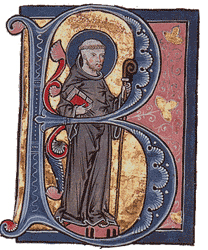

The Cistercians (/sɪˈstɜːrʃənz/), officially the Order of Cistercians (Latin: (Sacer) Ordo Cisterciensis, abbreviated as OCist or SOCist), are a Catholic religious order of monks and nuns that branched off from the Benedictines and follow the Rule of Saint Benedict, as well as the contributions of the highly-influential Bernard of Clairvaux, known as the Latin Rule. They are also known as Bernardines, after Saint Bernard, or as White Monks, in reference to the colour of their cowl, as opposed to the black cowl worn by Benedictines.
The term Cistercian derives from Cistercium, the Latin name for the locale of Cîteaux, near Dijon in eastern France. It was here that a group of Benedictine monks from the monastery of Molesme founded Cîteaux Abbey in 1098. The first three abbots were Robert of Molesme, Alberic of Cîteaux and Stephen Harding. Bernard helped launch a new era when he entered the monastery in the early 1110s with 30 companions. By the end of the 12th century, the order had spread throughout most parts of Europe.
The keynote of Cistercian life was a return to literal observance of the Benedictine Rule. The reform-minded monks tried to live monastic life as they thought it had been in Benedict's time; at various points they went beyond it in austerity. They returned to manual labour, especially agricultural work in the fields. The Cistercians made major contributions to culture and technology: Cistercian architecture is considered one of the most beautiful styles of medieval architecture, and the Cistercians were the main force of technological diffusion in fields such as agriculture and hydraulic engineering.
Over the centuries, education and scholarship came to dominate the life of many monasteries. A reform movement seeking a simpler lifestyle began in 17th-century France at La Trappe Abbey, and became known as the Trappists. They were eventually consolidated in 1892 into a new order called the Order of Cistercians of the Strict Observance, abbreviated as OCSO. The Cistercians who remained within the Order of Cistercians are called the Cistercians of the Common Observance (OCist).
Origins and early expansion
[edit]Foundation
[edit]
In 1098, a Benedictine abbot, Robert of Molesme, left Molesme Abbey in Burgundy with around 20 supporters, who felt that the Cluniac communities had abandoned the rigours and simplicity of the Rule of St. Benedict. Chief among Robert's followers included Alberic, a former hermit from the nearby forest of Colan, and Stephen Harding, a young monk from England.[1] Stephen had experienced the monastic traditions of the Camaldolese and Vallombrosians before joining Molesme Abbey.[2]
On 21 March 1098, Robert's small group acquired a plot of marshland just south of Dijon called Cîteaux (Latin: "Cistercium". Cisteaux means reeds in Old French), given to them expressly for the purpose of founding their Novum Monasterium.[3] During the first year, the monks set about constructing malodging areas and farming the lands of Cîteaux, making use of a nearby chapel for Mass. In Robert's absence from Molesme, however, the abbey had gone into decline, and Pope Urban II, a former Cluniac monk, ordered him to return.[4]
The remaining monks of Cîteaux elected Alberic as their abbot, under whose leadership the abbey would find its grounding. Robert had been the idealist of the order, and Alberic was their builder. Upon assuming the role of abbot, Alberic moved the site of the fledgling community near a brook a short distance away from the original site. Alberic discontinued the use of Benedictine black garments in the abbey and clothed the monks in white habits of undyed wool.[5] Alberic forged an alliance with the Dukes of Burgundy, working out a deal with Duke Odo I of Burgundy concerning the donation of a vineyard (Meursault) as well as materials for building the abbey church, which was consecrated on 16 November 1106 by the Bishop of Chalon sur Saône.[6]
On 26 January 1108, Alberic died and was succeeded by Stephen Harding, the man responsible for carrying the order into its crucial phase.
Cistercian reform
[edit]
Harding framed the original version of the Cistercian constitution, soon to be called the Carta Caritatis (Charter of Charity). Although it was revised on several occasions to meet contemporary needs, from the outset it emphasised a simple life of work, love, prayer and self-denial. The Cistercians soon came to distinguish themselves from Benedictines by wearing white or grey tunics instead of black; white habits are common for reform movements.[7] Much of Cistercian reform took place against the rivalry with the famous Benedictine abbey of Cluny, where wealth and excess were said to have set in.[8]
Harding acquired land for the abbey to develop to ensure its survival and ethic. As to grants of land, the order would normally accept only undeveloped land, which the monks then developed by their own labour. For this they developed over time a very large component of uneducated lay brothers known as conversi.[9] In some cases, the order accepted developed land and relocated the serfs elsewhere.[7]
Charter of Charity
[edit]The outlines of the Cistercian reform were adumbrated by Alberic, but it received its final form in the Carta caritatis (Charter of Charity), which was the defining guide on how the reform was to be lived.[10][11] This document governed the relations between the various houses of the Cistercian order, and exercised a great influence also upon the future course of western monachism. From one point of view, it may be regarded as a compromise between the primitive Benedictine system, in which each abbey was autonomous and isolated, and the centralization of Cluny.[12]
The Cistercians maintained the independence of individual houses: each abbey had its own abbot, elected by its own monks, and its own property and finances administered without outside interference. On the other hand, all the abbeys were subjected to the General Chapter, the constitutional body which exercised vigilance over the order. Made up of all the abbots, the General Chapter met annually in mid-September at Cîteaux. Attendance was compulsory, with the abbot of Cîteaux presiding.[13] He was to enforce conformity to Cîteaux in all details of monastic observance, liturgy, and customs. Cîteaux was always to be the model to which all the other houses had to conform.[14]
No vow of silence
[edit]Cistercian monks and nuns have a reputation of cultivating solitude and silence; the great monastics have explained silence as "the language of liberation, enlightenment, or union with God."[15] Some observers deduced, incorrectly, that Cistercians take a vow of silence.[16] Watching over one's tongue is, however, a general theme in the Rule of St. Benedict and never required a vow of silence.[17]
International expansion
[edit]In the year of 1113, a charismatic young Burgundinian nobleman named Bernard arrived at Cîteaux with 35 of his relatives and friends to join the monastery.[18] A supremely eloquent, strong-willed mystic, Bernard was to become the most admired churchman of his age. In 1115, Count Hugh of Champagne gave a tract of wild, afforested land known as a refuge for robbers, forty miles east of Troyes, to the order. Bernard, 25 years old at the time, led twelve other monks there, and they founded the Abbey of Clairvaux.[19] The abbey soon attracted zealous young men. At this point, Cîteaux had four daughter houses: Pontigny, Morimond, La Ferté and Clairvaux.
After Saint Bernard's entry, the Cistercian order began a notable epoch of international expansion. As his fame grew, the Cistercian movement grew with it.[20]
Austria
[edit]In 1129 Margrave Leopold the Strong of Styria called upon the Cistercians to develop his recently acquired March which bordered Austria on the south. He granted monks from the Ebrach Abbey in Bavaria an area of land just north of what is today the provincial capital Graz, where they founded Rein Abbey. At the time, it was the 38th Cistercian monastery founded. Due to the dissolution down the centuries of the earlier 37 abbeys, as of 2016, it was the oldest surviving Cistercian house in the world.[21]
Britain
[edit]The order entrusted the oversight of the English, Welsh and (intermittently) Irish abbeys to two or more abbots-commissary, thereby abrogating the famous Cistercian system of filiation: not the mother abbeys, but the abbots-commisary had full powers of visitation. This variation on the original vertical descent of authority produced "a system of centralized national control" much closer to that of the Premonstratensians or mendicants.[22] The first Cistercian house to be established in Britain, a monastery at Waverley Abbey, Surrey, was founded by William Gifford, Bishop of Winchester in 1128. It was founded with 12 monks and an abbot from L'Aumône Abbey, in the South of France. By 1187 there were 70 monks and 120 lay brothers in residence.[23]
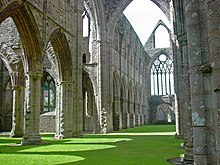
Thirteen Cistercian monasteries, all in remote locations, were founded in Wales between 1131 and 1226. The first of these was Tintern Abbey, which was sited in a remote river valley, and depended largely on its agricultural and pastoral activities for survival.[24] Other abbeys, such as at Neath, Strata Florida, Conwy and Valle Crucis became among the most hallowed names in the history of religion in medieval Wales.[25] Their austere discipline seemed to echo the ideals of the Celtic saints, and the emphasis on pastoral farming fit well into the Welsh stock-rearing economy.[25]
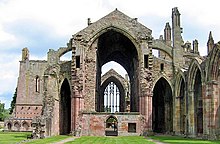
In Yorkshire, Rievaulx Abbey was founded from Clairvaux in 1131, on a small, isolated property donated by Walter Espec, with the support of Thurstan, Archbishop of York. By 1143, three hundred monks had entered Rievaulx, including the famous St Ælred. It was from Rievaulx that a foundation was made at Melrose, which became the earliest Cistercian monastery in Scotland. Located in Roxburghshire, it was built in 1136 by King David I of Scotland, and completed in less than ten years.[26] Another important offshoot of Rievaulx was Revesby Abbey in Lincolnshire.[27]
Fountains Abbey was founded in 1132 by discontented Benedictine monks from St. Mary's Abbey, York, who desired a return to the austere Rule of St Benedict. After many struggles and great hardships, St Bernard agreed to send a monk from Clairvaux to instruct them, and in the end they prospered. Already by 1152, Fountains had many offshoots, including Newminster Abbey (1137) and Meaux Abbey (1151).[27]
Ireland
[edit]In the spring of 1140, Saint Malachy, the archbishop of Armagh, visited Clairvaux, becoming a personal friend of Abbot Bernard and an admirer of Cistercian life. He left four of his companions to be trained as Cistercians, and returned to Ireland to introduce Cistercian monasticism there.[28] Mellifont Abbey was founded in County Louth in 1142 and from it daughter houses of Bective Abbey in County Meath (1147), Inislounaght Abbey in County Tipperary (1147–1148), Baltinglass in County Wicklow (1148), Monasteranenagh in County Limerick (1148), Kilbeggan in County Westmeath (1150) and Boyle Abbey in County Roscommon (1161).[29]
Following the Anglo-Norman invasion of Ireland in the 1170s, the English improved the standing of the Cistercian Order in Ireland with nine foundations: Dunbrody Abbey, Inch Abbey, Grey Abbey, Comber Abbey, Duiske Abbey, Abington, Abbeylara and Tracton.[30] This last abbey was founded in 1225 from Whitland Abbey in Wales, and at least in its earliest years, its monks were Welsh-speaking. By this time, another ten abbeys had been founded by Irishmen since the invasion, bringing the total number of Cistercian houses in Ireland to 31. This was almost half the number of those in England, but it was about thrice the number in each of Scotland and Wales.[31] Most of these monasteries enjoyed either noble, episcopal or royal patronage. In 1269, the Archbishop of Cashel joined the order and established a Cistercian house at the foot of the Rock of Cashel in 1272.[32] Similarly, the Irish-establishment of Abbeyknockmoy in County Galway was founded by King of Connacht, Cathal Crobhdearg Ua Conchobair, who died a Cistercian monk and was buried there in 1224.[33]

By 1152, there were 54 Cistercian monasteries in England, few of which had been founded directly from the Continent.[27] Overall, there were 333 Cistercian abbeys in Europe, so many that a halt was put to this expansion.[34] Nearly half of these houses had been founded, directly or indirectly, from Clairvaux, so great was St Bernard's influence and prestige. He later came popularly to be regarded as the founder of the Cistercians, who have often been called Bernardines.[12] Bernard died in 1153, one month after his pupil Eugene III.[35]
The Iberian Peninsula
[edit]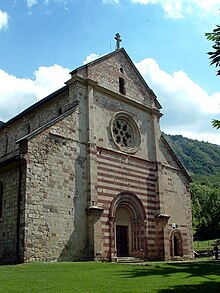

In 1153, the first King of Portugal, D. Afonso Henriques (Afonso, I), founded Alcobaça Monastery. The original church was replaced by the present construction from 1178. The abbey's church was consecrated in 1223. Two further building phases followed in order to complete the nave, leading to the final consecration of the medieval church building in 1252.[36]
As a consequence of the wars between the Christians and Moors on the Iberian Peninsula, the Cistercians established a military branch of the order in Castile in 1157: the Order of Calatrava. Membership of the Cistercian Order had included a large number of men from knightly families, and when King Alfonso VII began looking for a military order to defend the Calatrava, which had been recovered from the Moors a decade before, the Cistercian Abbot Raymond of Fitero offered his help. Lay brothers were to be employed as "soldiers of the Cross" to defend Calatrava. The initial successes of the new order in the Spanish Reconquista were convincing, and the arrangement was approved by the General Chapter at Cîteaux and successive popes; the Knights of Calatrava were given a definitive rule in 1187, modeled upon the Cistercian rule for lay brothers, which included the evangelical counsels of poverty, chastity, and obedience; specific rules of silence; abstinence on four days a week; the recitation of a fixed number of Pater Nosters daily; to sleep in their armour; and to wear, as their full dress, the Cistercian white mantle with the scarlet cross fleurdelisée.[37]
Calatrava was not subject to Cîteaux, but to Fitero's mother-house, the Abbey of Morimond in Burgundy. By the end of the 13th century, the knights had become a major autonomous power within the Castilian state, subject only to Morimond and the pope. They had abundant resources of men and wealth, lands and castles scattered along the borders of Castile, and feudal lordship over thousands of peasants and vassals. On more than one occasion, the Order of Calatrava brought to the field a force of 1200 to 2000 knights – considerable in medieval terms. Over time, as the Reconquista neared completion, the canonical bond between Calatrava and Morimond relaxed more and more, and the knights of the order became virtually secularized, finally undergoing dissolution in the 18th–19th centuries.[37]
The first Cistercian abbey in Bohemia was founded in Sedlec near Kutná Hora in 1142. In the late 13th century and early 14th century, the Cistercian order played an essential role in the politics and diplomacy of the late Přemyslid and early Luxembourg state, as reflected in the Chronicon Aulae Regiae. This chronicle was written by Otto and Peter of Zittau, abbots of the Zbraslav abbey (Latin: Aula Regia, "Royal Hall"), founded in 1292 by the King of Bohemia and Poland, Wenceslas II. The order also played the main role in the early Gothic art of Bohemia; one of the outstanding pieces of Cistercian architecture is the Alt-neu Shul, Prague. The first abbey in the present day Romania was founded on 1179, at Igris (Egres), and the second on 1204, the Cârța Monastery.
By the end of the 13th century, the Cistercian houses numbered 500.[38] In this period, the monks performed pastoral tasks in and outside of the monastery and began preaching and teaching, even though their movement originally forbade schools and parishes.[39] At the order's height in the 15th century, it would have nearly 750 houses.
It often happened that the number of lay brothers became excessive and out of proportion to the resources of the monasteries, there being sometimes as many as 200, or even 300, in a single abbey. On the other hand, in some countries, the system of lay brothers in course of time worked itself out; thus in England by the close of the 14th century it had shrunk to relatively small proportions, and in the 15th century the regimen of the English Cistercian houses tended to approximate more and more to that of the Black Monks.[12]
Influence with popes and kings
[edit]Cistercian influence more than kept pace with the material expansion.[40] St. Bernard had become mentor to popes and kings, and in 1145, King Louis VII's brother, Henry of France, entered Clairvaux.[41] That same year, Bernard saw one of his monks elected pope as Pope Eugene III.[42] Eugene was an Italian of humble background, who had first been drawn to monasticism at Clairvaux by the magnetism of Bernard. At the time of his election, he was Abbot of Saints Vincenzo and Anastasio outside Rome.[43]
A considerable reinforcement to the Order was the merger of the Savigniac houses with the Cistercians, at the insistence of Eugene III. Thirteen English abbeys, of which the most famous were Furness Abbey and Jervaulx Abbey, thus adopted the Cistercian formula.[27] In Dublin, the two Savigniac houses of Erenagh and St Mary's became Cistercian.[29] It was in the latter case that medieval Dublin acquired a Cistercian monastery in the very unusual suburban location of Oxmantown, with its own private harbour called The Pill.[44]
Decline and attempted reforms
[edit]For a hundred years, until the first quarter of the 13th century, the Cistercians supplanted Cluny as the most powerful order and the chief religious influence in western Europe. But then in turn their influence began to wane, as the initiative passed to the mendicant orders,[12] in Ireland,[45] Wales[25] and elsewhere.
Relaxations were gradually introduced into Cistercian life with regard to diet and to simplicity of life, and also in regard to the sources of income, rents and tolls being admitted and benefices incorporated, as was done among Benedictines and other comparable orders. The farming operations tended to produce a commercial spirit; wealth and splendour characterized the monasteries, and the choir monks abandoned manual labour. Two important papal bulls tried to introduce reforms: Clement IV's Parvus fons and Benedict XII's Fulgens sicut stella matutina. The General Chapter continued to battle against abuses.[12]

In Ireland, the information on the Cistercian Order after the Anglo-Norman invasion gives a rather gloomy impression.[46] Absenteeism among Irish abbots at the General Chapter became a persistent and much criticised problem in the 13th century, and escalated into the conspiratio Mellifontis, a "rebellion" by the abbeys of the Mellifont filiation. Visitors were appointed to reform Mellifont on account of the multa enormia that had arisen there, but in 1217 the abbot refused their admission and had lay brothers bar the abbey gates. There was also trouble at Jerpoint, and alarmingly, the abbots of Baltinglass, Killenny, Kilbeggan and Bective supported the actions of the "revolt".[47]
In 1228, the General Chapter sent the Abbot of Stanley in Wiltshire, Stephen of Lexington, on a well-documented visitation to reform the Irish houses.[48] A graduate of both Oxford and Paris, and a future Abbot of Clairvaux (to be appointed in 1243), Stephen was one of the outstanding figures in 13th-century Cistercian history, having founded the College of St. Bernard in Paris in 1244.[49] He found his life threatened as a result of the Irish visitations: his representatives were attacked and his party harassed, while the three key houses of Mellifont, Suir and Maigue had been fortified by monks to hold out against him.[50] However, with the help of his assistants, the core of obedient Irish monks and the aid of both English and Irish secular powers, he was able to envisage the reconstruction of the Cistercian province in Ireland.[51] Stephen dissolved the Mellifont filiation altogether, and subjected 15 monasteries to houses outside Ireland.[46] In breadth and depth, his instructions constituted a radical reform programme: "They were intended to put an end to abuses, restore the full observance of the Cistercian way of life, safeguard monastic properties, initiate a regime of benign paternalism to train a new generation of religious, isolate trouble-makers and institute an effective visitation system."[52] The arrangement lasted almost half a century, and in 1274, the filiation of Mellifont was reconstituted.[53]
In Germany the Cistercians were instrumental in the spread of Christianity east of the Elbe. They developed grants of territories of 180,000 acres where they would drain land, build monasteries and plan villages. Many towns near Berlin owe their origins to this order, including Heiligengrabe and Chorin; its Chorin Abbey was the first brick-built monastery in the area.[54] By this time, however, "the Cistercian order as a whole had experienced a gradual decline and its central organisation was noticeably weakened."[53]
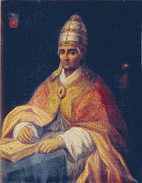
In 1335, the French cardinal Jacques Fournier, a Cistercian monk, was elected and consecrated Pope Benedict XII. He was devoted to reducing the culture of nepotism at the Vatican. He promulgated a series of regulations to restore the spirit of reform in the Cistercian Order.[55]
By the 15th century, however, the Cistercians had fallen on dark days. The General Chapter lost virtually all its power to enforce its decrees, and the strength of the order which derived from this uniformity declined. Wars, amon them the Hundred Years' War, and a lack of leadership did damage. Many of the monasteries were controlled by dynasties who appointed their relatives to leadership positions, and pocketed the abbeys' profits. The system of placing abbeys in commendam was widespread and led to the spiritual and material decline of many abbeys.[56]
The Order during the Protestant Reformation
[edit]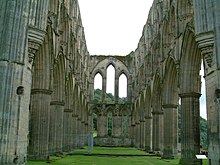
Germany became the scene of violence and destabilization following Martin Luther's efforts to gain independence from the Vatican. Many abbeys lost scores of monks, as these left religious life in order to marry. Monastic property was confiscated by nobles who saw an opportunity to proift from the chaos. During the English Reformation, Henry VIII's Dissolution of the Monasteries saw the confiscation of evey single monastery in that country, a disaster not only for the Cistercians. Some historians believe that the suppression of the English monasteries may have stamped out an industrial revolution.[57]
After the Reformation
[edit]
The reformed Congregation of the Feuillants spread widely in France and Italy in the 16th century. The French congregation of Sept-Fontaines (1654) also deserves mention. In 1663 Jean de Rancé reformed La Trappe (see Trappists).[58]
In the 17th century another great effort at a general reform was made, promoted by the pope and the king of France; the general chapter elected Richelieu to be (commendatory) abbot of Cîteaux, thinking he would protect them from the threatened reform. In this they were disappointed, for he threw himself wholly on the side of reform. A formidable battle ensued, making it clear that Italian and Central European abbeys did not want to go the way of the Trappists. Civic politics also played a role in the conflict.[59]
The Protestant Reformation, the ecclesiastical policy of Emperor Joseph II, the French Revolution, and the revolutions of the 18th century almost wholly destroyed the Cistercians. But some survived, and from the beginning of the last half of the 19th century there was a considerable recovery.[12]
In 1892, the Trappists left the Cistercians and founded a new order, named the Order of Cistercians of the Strict Observance.[60] The Cistercians that remained within the original order thus came to be known as the "Common Observance".[12]
Influence
[edit]Architecture
[edit]
Cistercian architecture has made an important contribution to European civilisation. Architecturally speaking, the Cistercian monasteries and churches, owing to their pure style, may be counted among the most beautiful relics of the Middle Ages.[27] Cistercian foundations were primarily constructed in Romanesque and Gothic architecture during the Middle Ages; although later abbeys were also constructed in Renaissance and Baroque.[citation needed]
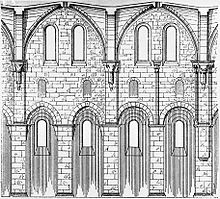
In the mid-12th century, one of the leading churchmen of his day, the Benedictine Abbot Suger of Saint-Denis, united elements of Norman architecture with elements of Burgundinian architecture (rib vaults and pointed arches respectively), creating the new style of Gothic architecture.[61] This new "architecture of light" was intended to raise the observer "from the material to the immaterial"[62] – it was, according to the 20th-century French historian Georges Duby, a "monument of applied theology".[63] Although St. Bernard saw much of church decoration as a distraction from piety, and the builders of the Cistercian monasteries had to adopt a style that observed the numerous rules inspired by his austere aesthetics, the order itself was receptive to the technical improvements of Gothic principles of construction and played an important role in its spread across Europe.[64]
This new Cistercian architecture embodied the ideals of the order, and was in theory at least utilitarian and without superfluous ornament.[65] The same "rational, integrated scheme" was used across Europe to meet the largely homogeneous needs of the order.[65] Various buildings, including the chapter-house to the east and the dormitories above, were grouped around a cloister, and were sometimes linked to the transept of the church itself by a night stair.[65] Usually Cistercian churches were cruciform, with a short presbytery to meet the liturgical needs of the brethren, small chapels in the transepts for private prayer, and an aisled nave that was divided roughly in the middle by a screen to separate the monks from the lay brothers.[66]
Engineering and construction
[edit]
The building projects of the Church in the High Middle Ages showed that the era encourage colossal architecture, with vast amounts of stone being quarried; the same was true of the Cistercian projects.[67] Foigny Abbey was 98 metres (322 ft) long, and Vaucelles Abbey was 132 metres (433 ft) long.[67] Monastic buildings came to be constructed entirely of stone, right down to the most humble of buildings. In the 12th and 13th centuries, even Cistercian barns consisted had stone exteriors.[68]
The Cistercians acquired a reputation as masters in administering ecclesial construction projects.[69] St. Bernard's own brother, Achard, is known to have supervised the construction of many abbeys, such as Himmerod Abbey in the Rhineland.[69] On one occasion the abbot of La Trinité at Vendôme loaned a monk named John to the Bishop of Le Mans, Hildebert de Lavardin, for the building of a cathedral; after the project was completed, John refused to return to his monastery.[69] However, the monks did not construct their edifices alone. As early as 1133, St. Bernard was hiring workers to help the monks erect new buildings at Clairvaux.[70] An illustration from the 16th century shows monks working alongside other craftsmen at Schönau Abbey.[70]
Legacy
[edit]
The Cistercian abbeys of Fontenay in France,[71] Fountains in England,[72] Alcobaça in Portugal,[73] Poblet in Spain[74] and Maulbronn in Germany are today recognised as UNESCO World Heritage Sites.[75]
The abbeys of France and England are fine examples of Romanesque and Gothic architecture. The architecture of Fontenay has been described as "an excellent illustration of the ideal of self-sufficiency" practised by the earliest Cistercian communities.[71] The abbeys of 12th century England were stark and undecorated – a dramatic contrast with the elaborate churches of the wealthier Benedictine houses – yet to even the Cistercian ruins, such as in Fountains and Tinturn Abbey, attracted many tourists, pilgrims and poets.[76]
In the purity of architectural style, the beauty of materials and the care with which the Alcobaça Monastery was built,[73] Portugal possesses one of the most outstanding and best preserved examples of Early Gothic.[77] Poblet Monastery, one of the largest in Spain, is considered similarly impressive for its austerity, majesty, and the fortified royal residence within.[74]

The fortified Maulbronn Abbey in Germany is considered "the most complete and best-preserved medieval monastic complex north of the Alps".[75] The Transitional Gothic style of its church had a major influence in the spread of Gothic architecture over much of northern and central Europe, and the abbey's elaborate network of drains, irrigation canals and reservoirs has since been recognised as having "exceptional" cultural interest.[75]
In Poland, the former Cistercian monastery of Pelplin Cathedral is an important example of Brick Gothic. Wąchock Abbey is one of the most valuable examples of Polish Romanesque architecture.[78] The largest Cistercian complex, the Abbatia Lubensis (Lubiąż, Poland), is a masterpiece of baroque architecture and the second largest Christian architectural complex in the world.[79]
Art
[edit]The mother house of the order, Cîteaux, had developed an advanced style of painting in illuminated manuscripts during the first decades of the 12th century. However, as Bernard of Clairvaux's influence increased, decoration gradually diminished in Cistercian manuscripts. He had a strong aversion to the extensive use of imagery. Decorations were finally banned altogether in the order. Any wall paintings that may have existed were presumably destroyed. Crucifixes were allowed, and later some painting and decoration crept back in.[80] Bernard criticized abbey churches for their "immoderate length, their superfluous breadth, the costly polishings, the curious carvings and paintings which attract the worshipper's gaze and hinder his attention." He loathed the fantastical, often deformed beasts used in medievial church decoration. Weaker monks would be tempted "to spend the whole day in wondering at these things rather than in meditating the law of God."[81]
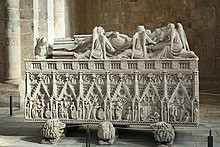
Nonetheless, many Cistercian abbey churches housed the tombs of royal or noble patrons, and these were often elaborately carved and painted. Notable dynastic burial places were Alcobaça for the Kings of Portugal, Cîteaux for the Dukes of Burgundy, and Poblet for the Kings of Aragon. Corcomroe in Ireland contains one of only two surviving examples of Gaelic royal effigies from 13th and 14th century Ireland.[82]
Agriculture, technology, and commerce
[edit]
Successful farmers, the white monks introduced and propagated many improvements in medieval agriculture.[83] They developed an organised system for selling produce, cattle and horses, and notably contributed to commercial progress in Western Europe.[84] To the wool and cloth trade, which was especially fostered by the Cistercians, England was largely indebted for the beginnings of her commercial prosperity.[27]
From the beginning, the monks used a system of lay brothers and employees to operate their farms; monks and priests were busy with their liturgical and sacramental duties. The lay brothers formed a body of men who lived alongside of the choir monks, but separate from them, not taking part in the canonical office, but having their own fixed round of prayer and religious exercises. They were not ordained, nor did they have a voice in the monks' chapter.[85]

Until the Industrial Revolution, most of the technological advances in Europe were made in the monasteries.[86] According to the medievalist Jean Gimpel, their high level of industrial technology facilitated the diffusion of new techniques: "Every monastery had a model factory, often as large as the church and only several feet away, and waterpower drove the machinery of the various industries located on its floor."[87] Waterpower was used for crushing wheat, sieving flour, fulling cloth and tanning – a technological achievement in use in practically all of the order's monasteries.[88] The monks used their own numbering system, which could express all the numbers from 0 to 9999 in a single sign.[89]
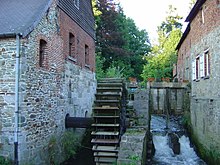
The Cistercian order was innovative in developing techniques of hydraulic engineering for monasteries established in remote valleys.[64] In Spain, one of the earliest surviving Cistercian houses, the Real Monasterio de Nuestra Senora de Rueda in Aragon, is a good example of such early hydraulic engineering, using a large waterwheel for power and an elaborate water circulation system for central heating.
The Cistercians are known to have been skilled metallurgists, and knowledge of their technological advances was transmitted by the order.[90] Iron ore deposits were often donated to the monks along with forges to extract the iron, and within time surpluses were being offered for sale. The Cistercians became the leading iron producers in Champagne, from the mid-13th century to the 17th century, also using the phosphate-rich slag from their furnaces as an agricultural fertiliser.[91] The forge at Fontenay abbey, for instance, is not on the margins of the abbey grounds, but within the monastic enclosure itself. Cistercian innovations may have shaped the very course of Gothic architecture.[92]
Theology
[edit]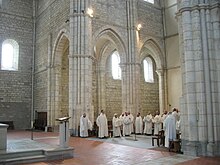
By far the most influential of the early Cistercians was Bernard of Clairvaux. He attracted vocations, served as a papal envoy, and attracted international attention to the movement: he was "one of the most influential churchmen of his time."[93] Bernard was an ascetic and intellectual, which he demonstrated in his sermons on Grace, Free will and the Song of Songs.[41] He was quick to recognise heretical ideas, and in 1141 and 1145 respectively, he accused the celebrated scholastic theologian Peter Abelard and the popular preacher Henry of Lausanne of heresy.[41] He was also charged with the task of promulgating Pope Eugene's bull, Quantum praedecessores, and his eloquence in preaching the Second Crusade recruited many to the cause.[94]
Although Bernard's De laude novae militiae was in favour of the Knights Templar,[95] the English Cistercian Abbot Isaac of Stella, near Poitiers, preached against the very same group as a "new monstrosity".[95] In the course of the 12th and 13th centuries, many Cistercian authors wrote on spiritual topics.[96] The "four evangelists" of the movement are: Bernard, William of Saint Thierry, Aelred of Rievaulx, and Guerric of Igny. Besides Bernard, the others were only re-discovered in the 20th century.[97]
Cistercians today
[edit]
Many Cistercian monasteries make produce goods such as cheese, bread, and craft products. In the United States, some abbeys support themselves through agriculture, forestry and real estate. European Trappist monasteries are known for their beer.[98]
Cistercian nuns
[edit]
There are a large number of Cistercian nuns. At the period of their widest extension there may have been over 900 women's monasteries, but some were not officially integrated into the order. The first community, Tart, was founded 1125 in the Diocese of Langres.[99] One of the best known of Cistercian women's communities was the Abbey of Port-Royal, associated with the Jansenist controversy.[100] In Spain and France, a number of Cistercian abbesses had extraordinary privileges.[101][102]
See also
[edit]References
[edit]- ^ Read, p 94
- ^ "Stephen Harding, St. | Encyclopedia.com". www.encyclopedia.com. Retrieved 21 November 2021.
- ^ Tobin, pp 29, 33, 36.
- ^ Read, pp 94–95
- ^ Gildas, Marie. "Cistercians." The Catholic Encyclopedia Vol. 3. New York: Robert Appleton Company, 1908. 21 January 2020
 This article incorporates text from this source, which is in the public domain.
This article incorporates text from this source, which is in the public domain.
- ^ Tobin, pp 37–38.
- ^ a b Hollister, p 209
- ^ Lekai, Ideals and Reality, p. 25.
- ^ Hollister, p 209–10
- ^ "Latin text". Users.skynet.be. Archived from the original on 3 March 2016. Retrieved 18 January 2010.
- ^ Migne, Patrol. Lat. clxvi. 1377
- ^ a b c d e f g Butler 1911, p. 394.
- ^ Watt, p 52
- ^ See F. A. Gasquet, Sketch of Monastic Constitutional History, pp. xxxv–xxxviii, prefixed to English trans. Of Montalembert's Monks of the West, ed. 1895
- ^ Teahan, John F. (1982). "Solitude: A Central Motif in Thomas Merton's Life and Writings". Journal of the American Academy of Religion. 50 (4): 521–538. ISSN 0002-7189.
- ^ Fermor, Patrick Leigh (9 November 2011). A Time to Keep Silence. New York Review of Books. p. 93. ISBN 978-1-59017-521-7.
- ^ Hastings, James; Selbie, John Alexander; Gray, Louis Herbert (1922). Encyclopaedia of Religion and Ethics. Vol. 12. Scribner. p. 650.
- ^ Lekai, Ideals and Reality, p. 19.
- ^ Read, p 93, 95
- ^ Holdsworth, Christopher (22 November 2012), Birkedal Bruun, Mette (ed.), "Bernard of Clairvaux: his first and greatest miracle was himself", The Cambridge Companion to the Cistercian Order (1 ed.), Cambridge University Press, pp. 173–185, doi:10.1017/cco9780511735899.017, ISBN 978-1-107-00131-2, retrieved 3 November 2024
- ^ Andrée, Alexander; Sharp, Tristan; Shaw, Richard (2016). "Aquinas and "Alcuin": A New Source of the "Catena Aurea" on John". Recherches de théologie et philosophie médiévales. 83 (1): 3–20. ISSN 1370-7493.
- ^ Knowles, David (1979). The Religious Orders in England. Cambridge University Press. p. 28. doi:10.1017/cbo9780511560668.004. ISBN 978-0-521-29568-0.
- ^ Graham, Rose (1929). "The Great Schism and the English Monasteries of the Cistercian Order". The English Historical Review. 44 (175): 373–387. ISSN 0013-8266.
- ^ Dykes, pp 76–78
- ^ a b c Roderick, p 164
- ^ Michael Barrett (1 October 1911). "Abbey of Melrose". Catholic Encyclopedia. Retrieved 18 January 2010.
- ^ a b c d e f Herbert Thurston. "Cistercians in the British Isles". Catholic Encyclopedia. NewAdvent.org. Retrieved 18 June 2008.
- ^ Watt, p. 20
- ^ a b Watt, p 21
- ^ Watt, pp 49–50
- ^ Watt, p 50
- ^ Watt, p 115
- ^ Doran, p 53
- ^ Logan, p 139
- ^ Read, p 126
- ^ Toman, p 98
- ^ a b Charles Moeller (1 November 1908). "Military Order of Calatrava". Catholic Encyclopedia. Retrieved 18 January 2010.
- ^ "Cistercian Order of the Strict Observance (Trappists): Frequently Asked Questions". Ocso.org. 8 December 2003. Archived from the original on 17 September 2009. Retrieved 18 January 2010.
- ^ Jamroziak, Emilia (2024). "Cistercians and the Care of Souls from the Twelfth to the Early Sixteenth Century". In Ōnuki, Toshio; Melville, Gert; Akae, Yūichi; Takeda, Kazuhisa (eds.). Pastoral care and monasticism in Latin christianity and Japanese buddhism (ca. 800-1650). Vita regularis Abhandlungen. Münster: LIT. ISBN 978-3-643-15497-2.
- ^ Butler 1911, p. 393.
- ^ a b c Read, p 118
- ^ Read, pp 117–118
- ^ Read, p. 117
- ^ Clarke, pp 42–43
- ^ Lalor, p 200
- ^ a b Richter, p 154
- ^ Watt, p. 53
- ^ Watt, p. 55
- ^ Merton, Thomas; Grimes, William R.; Merton, Thomas (2019). O'Connell, Patrick F. (ed.). Medieval Cistercian history. Initiation into the monastic tradition / Thomas Merton. Collegeville, Minnesota: Liturgical Press. p. 217. ISBN 978-0-87907-043-4.
- ^ Watt, p. 56
- ^ Watt, pp. 56–57
- ^ Watt, p. 59
- ^ a b Richter, p. 155
- ^ Richie, p. 21
- ^ Wiedemann, Benedict G E (28 July 2020). "Pope Benedict XII (1334–1342): The Guardian of Orthodoxy, ed. Irene Bueno". The English Historical Review. 135 (573): 464–466. doi:10.1093/ehr/ceaa020. ISSN 0013-8266.
- ^ Lekai, Ideals and Reality, pp. 91-108.
- ^ David Derbyshire, 'Henry "Stamped Out Industrial Revolution"', The Daily Telegraph (21 June 2002); cited by Woods, p 37.
- ^ Petruzzello, Melissa. "Trappist". www.britannica.com. Retrieved 19 October 2024.
- ^ Hayden, J. Michael (1972). "Review of The Rise of the Cistercian Strict Observance in Seventeenth Century France (Book review)". The Catholic Historical Review. 57 (4): 664–665. ISSN 0008-8080. JSTOR 25018975.
- ^ Alcuin Schachenmayr and Polycarp Zakar: Union And Division: The Proceedings of the Three Trappist Congregations at their General Chapter in 1892. In: Analecta Cisterciensia 56 (2006) 334–384.
- ^ Toman, pp 8–9
- ^ Toman, p 9
- ^ Toman, p 14
- ^ a b Toman, p 10
- ^ a b c Lalor, p 1
- ^ Lalor, p 1, 38
- ^ a b Erlande-Brandenburg, p 32–34
- ^ Erlande-Brandenburg, p 28
- ^ a b c Erlande-Brandenburg, p 50
- ^ a b Erlande-Brandenburg, p 101
- ^ a b "Cistercian Abbey of Fontenay (No. 165)". UNESCO World Heritage Sites list. unesco.org. Retrieved 7 August 2009.
- ^ "Studley Royal Park including the Ruins of Fountains Abbey (No. 372)". UNESCO World Heritage Sites list. unesco.org. Retrieved 7 August 2009.
- ^ a b "Monastery of Alcobaça (No. 505)". UNESCO World Heritage Sites list. unesco.org. Retrieved 7 August 2009.
- ^ a b "Poblet Monastery (No. 518)". UNESCO World Heritage Sites list. unesco.org. Retrieved 7 August 2009.
- ^ a b c "Maulbronn Monastery Complex (No. 546)". UNESCO World Heritage Sites list. unesco.org. Retrieved 7 August 2009.
- ^ Kennedy, Deborah (2002). "Wordsworth, Turner, and the Power of Tintern Abbey". The Wordsworth Circle. 33 (2): 79–84. doi:10.1086/TWC24044961. ISSN 0043-8006. JSTOR 24044961.
- ^ Toman, p 289
- ^ Bialoskorska, Krystina (1965). "Polish Cistercians Architecture and Its Contacts with Italy". Gesta. 4: 14–22. doi:10.2307/766680. ISSN 0016-920X. JSTOR 766680.
- ^ Hauptmann-Fischer, Ewa; Kapelański, Maksymilian (2019). "The Cistercian Musical Practice in Eighteenth-Century Silesia in Light of Surviving Musical and Archival Collections". Fontes Artis Musicae. 66 (2): 138–155. ISSN 0015-6191. JSTOR 26776433.
- ^ Dodwell, 211–214
- ^ "Bernard's letter". Employees.oneonta.edu. Retrieved 18 January 2010.
- ^ Doran, p 48
- ^ Janovský, Martin (2024). "Stable isotope analysis in soil prospection [sic] reveals the type of historic land‑use under contemporary temperate forests in Europe". Scientific Reports. 14. doi:10.1038/s41598-024-63563-1. PMC 11208554.
the Cistercian Order has been renowned for its role in bringing into cultivation often inhospitable, marginal landscapes in different regions of Europe. Present-day landscapes still preserve various traces of their economic activities.
- ^ Hoffman Berman, Constance (22 November 2012), Birkedal Bruun, Mette (ed.), "Agriculture and economies", The Cambridge Companion to the Cistercian Order (1 ed.), Cambridge University Press, pp. 112–124, doi:10.1017/cco9780511735899.012, ISBN 978-1-107-00131-2, retrieved 3 November 2024
- ^ France, James (2012). Separate but equal: Cistercian lay brothers, 1120-1350. Cistercian studies series. Trappist, Ky. : Collegeville, Minn: Cistercian Publications ; Liturgical Press. ISBN 978-0-87907-246-9.
- ^ Rob Baedeker (24 March 2008). "Good Works: Monks build multimillion-dollar business and give the money away". San Francisco Chronicle. Retrieved 7 August 2009.
- ^ Gimpel, p 67. Cited by Woods.
- ^ Woods, p 33
- ^ King, David A. (2001). The Ciphers of the Monks: a forgotten number-notation of the Middle Ages. Stuttgart: F. Steiner. pp. 16, 29, 34, 41. ISBN 3-515-07640-9. OCLC 48254993.
- ^ Woods, pp 34–35
- ^ Gimpel, p 68; cited by Woods, p 35
- ^ Erlande-Brandenburg, pp 116–117
- ^ Meyer, John Richard (12 October 2024). "Saint Bernard of Clairvaux". Britannica.com. Retrieved 17 October 2024.
- ^ Read, p. 119
- ^ a b Read, p. 180
- ^ Elder, E. Rozanne (22 November 2012), Birkedal Bruun, Mette (ed.), "Early Cistercian writers", The Cambridge Companion to the Cistercian Order (1 ed.), Cambridge University Press, pp. 199–217, doi:10.1017/cco9780511735899.019, ISBN 978-1-107-00131-2, retrieved 4 June 2024
- ^ McGinn, Bernard (1977). "Introduction". In McGinn, Bernard (ed.). Three treatises on man: a Cistercian anthropology. Cistercian fathers series. Kalamazoo, Mich: Cistercian Publications. p. 27. ISBN 978-0-87907-024-3.
- ^ Castle, Stephen (11 July 2023). "At This Brewery, Blessings Are as Important as Barley and Hops". The New York Times.
There are just a dozen Trappist breweries worldwide, most in Belgium and the Netherlands.
- ^ Berthier, Karine (2001). "De la campagne à la ville, du XIIe au XVIIe siècle : Notre-Dame de Tart". In Montulet-Henneau, Marie-Elisabeth (ed.). Cîteaux et les femmes. ISBN 9782907150996.
- ^ Norberg, Kathryn (2012). "Review of Feminism, Absolutism, and Jansenism: Louis XIV and the Port-Royal Nuns". The American Historical Review. 117 (4): 1303–1304. doi:10.1093/ahr/117.4.1303. ISSN 0002-8762. JSTOR 23428020.
- ^ Ghislain Baury, "Emules puis sujettes de l'ordre cistercien. Les cisterciennes de Castille et d'ailleurs face au Chapitre Général aux XIIe et XIIIe siècles", Cîteaux: Commentarii cistercienses, t. 52, fasc. 1–2, 2001, p. 27–60. Ghislain Baury, Les religieuses de Castille. Patronage aristocratique et ordre cistercien, XIIe-XIIIe siècles, Rennes, Presses Universitaires de Rennes, 2012.
- ^ Escrivá de Balaguer, José María; Blanco, María; Martín, María del Mar (2016). La abadesa de Las Huelgas. Obras completas de San Josemaría Serie I, Obras publicadas. Madrid: Ediciones Rialp. ISBN 978-84-321-4687-9.
Literature
[edit]- This article incorporates text from a publication now in the public domain: Butler, Edward Cuthbert (1911). "Cistercians". In Chisholm, Hugh (ed.). Encyclopædia Britannica. Vol. 6 (11th ed.). Cambridge University Press. pp. 393–395.
- Clarke, Howard B.; Dent, Sarah; Johnson, Ruth (2002). Dublinia: The Story of Medieval Dublin. Dublin: O'Brien. ISBN 978-0-86278-785-1.
- Dodwell, C.R.; The Pictorial arts of the West, 800–1200, (1993), Yale UP, ISBN 0-300-06493-4
- Doran, Linda; Lyttleton, James, eds. (2008). Lordship in Medieval Ireland: Image and reality (Hardback, illustrated ed.). Four Courts Press. ISBN 978-1-84682-041-0.
- Dykes, D.W. (1980). Alan Sorrell: Early Wales Re-created. National Museum of Wales. ISBN 978-0-7200-0228-7.
- Gimpel, Jean, The Medieval Machine: The Industrial Revolution of the Middle Ages New York, Penguin, (1976) [ISBN missing]
- Hollister, C. Warren (1992) [1966]. The Making of England, 55 BC to 1399. Volume I of A History of England, edited by Lacey Baldwin Smith (6th ed.). Lexington, MA: D.C. Heath. ISBN 978-0-669-24457-1.
- Lekai, Louis (1977). The Cistercians: Ideals and Reality. The Kent State University Press, 1977. ISBN 978-0-873-38201-4.
- Logan, F. Donald, A History of the Church in the Middle Ages. [ISBN missing]
- Richter, Michael (2005). Medieval Ireland: the enduring tradition (Revised, illustrated ed.). Gill & Macmillan. ISBN 978-0-7171-3293-5.
- Rudolph, Conrad, "The 'Principal Founders' and the Early Artistic Legislation of Cîteaux", Studies in Cistercian Art and Architecture 3, Cistercian Studies Series 89 (1987) 1–45
- Rudolph, Conrad, Violence and Daily Life: Reading, Art, and Polemics in the Cîteaux Moralia in Job (1997) [ISBN missing]
- Tobin, Stephen. The Cistercians: Monks and Monasteries in Europe. The Herbert Press, LTD (1995). ISBN 1-871569-80-X.
- Toman, Rolf, ed. (2007). The Art of Gothic: Architecture, Sculpture, Painting. photography by Achim Bednorz. Tandem Verlag GmbH. ISBN 978-3-8331-4676-3.
- Watt, John, The Church in Medieval Ireland. University College Dublin Press; 2nd Rev. ed. (1998). ISBN 978-1-900621-10-6.
External links
[edit]- Official website
- Website on Cistercian Order, Architecture and History (Italian)
- Newadvent.org, Catholic Encyclopedia
- EUCist News, a blog about current Cistercian research in English and German
- Carta Caritatis Archived 3 March 2016 at the Wayback Machine (Latin)
- Center for Cistercian and Monastic Studies
- European route of Cistercian abbeys

